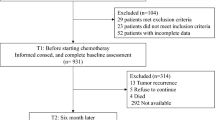Abstract
Eighty-nine patients with generalized malignant melanoma, 63% men and median age 53 years, were included in a longitudinal quality of life (QOL) study before the start of chemotherapy. QOL was assessed by the EORTC core questionnaire technique (QLQ-C36), a study-specific melanoma (MM) module and the Hospital Anxiety and Depression (HAD) scale. The questionnaires displayed good psychometric qualities and were able to document the florid symptomatology of disseminated melanoma. They were well accepted by the patients. Before treatment the patients reported a relatively low symptom burden, good physical and social functioning, moderate psychological distress and a high overall QOL rating during the past week. Fatigue and pain were the most frequent symptoms reported. The QOL measurement differentiated between subgroups of patients differing in performance status and the tumour burden. We conclude that the EORTC questionnaire technique is feasible and clinically relevant in generalized malignant melanoma patients.
Similar content being viewed by others
References
Jensen ON, Bolander AM. Trends in malignant melanoma of the skin. World Health Stat Q 1980; 33: 2–26.
Thörn M, Adami HO, Bergström R, et al. Trends in survival from malignant melanoma: Remarkable improvement in 23 years. J Natl Cancer Inst 1989; 81: 611–617.
National Board of Health and Welfare. Cancer Incidence in Sweden. Stockholm: The Cancer Registry, 1984: 16.
The Swedish Melanoma Study Group. Vårdprogram för malignt hudmelanom (Care program for cutaneous malignant melanoma). Stockholm: David Brobergs AB, 1976.
Ringborg U, Rudenstam CM, Hafstöm L, et al. Dacarbazine versus dacarbazine-vindesine in disseminated malignant melanoma: a randomized phase II study. Med Oncol Tumor Pharmacother 1989; 6: 285–289.
Ringborg U, Jungelius U, Hansson J, et al. Dacarbazine-vindesine-cisplatinum in disseminated malignant melanoma: A phase I–II trial. Am J Clin Oncol 1990; 13: 214–217.
Lakhani S, Selby P, Bliss JM, et al. Chemotherapy for malignant melanoma: combinations and high doses produce more response without survival benefit. Br J Cancer 1990; 61: 330–334.
Cocconi G, Bella M, Calabresi F, et al. Treatment of metastatic malignant melanoma with dacarbazine plus tamoxifen. N Engl J Med 1992; 327: 516–523.
Guerry D, Schuchter LM. Disseminated melanoma—is there a new standard therapy? N Engl J Med 1992; 327: 560–561.
deHaes JCJM, vanKnippenberg FCE. The quality of life of cancer patients: a review of the literature. Soc Sci Med 1985; 20: 809–817.
Cella DF, Tulsky DS. Measuring quality of life today: methodological aspects. Oncology 1990; 4: 29–38.
Aaronson NK, Meyerowitz BE, Bard M, et al. Quality of life research in oncology: Past achievements and future priorities. Cancer 1991; 67: 839–843.
Aaronson NK, Ahmedzai S, Bullinger M, et al. The EORTC Core Quality-Of-Life Questionnaire: Interim Results of an International Field Study. In: Osoba D, ed. Effect of Cancer on Quality of Life. Boca Raton: CRC Press Inc., 1991: 185–203.
Aaronson NK, Ahmedzai S, Bergman B, et al. The EORTC QOLQ-C30: A quality of life instrument for use in international clinical trials in oncology. J Natl Cancer Inst 1993; 85: 365–376.
Longman AJ, Graham KY. Living with Melanoma: Content analysis of interviews. Oncol Nurs Forum 1986; 13: 58–64.
Zigmond AS, Snaith RP. The Hospital Anxiety and Depression scale. Acta Psyciatr Scand 1983; 67: 361–370.
Bergman B, Sullivan M, Sörenson S. Quality of life during chemotherapy for small cell lung cancer. I. An evaluation with generic health measures. Acta Oncol 1991; 30: 947–957.
Bergman B, Sullivan M, Sörenson S. Quality of life during chemotherapy of small cell lung cancer. II. A longitudinal study of the EORTC Core Quality of Life Questionnaire and comparison with the Sickness Impact Profile. Acta Oncol 1992; 31: 19–28.
Lundqvist C, Siösteen A, Blomstrand C, et al. Spinal cord injuries. Clinical, functional and emotional status. Spine 1991; 16: 78–83.
Brandberg Y, Bolund C, Sigurdardóttir V, et al. Anxiety and depressive symptoms at different stage of malignant melanoma. Psycho-Oncology 1992; 2: 71–78.
Likert R. A technique for the measurement of attitudes. Arch Psychol 1932; 140: 1–55.
Nie NH, Hull CH, Jenkins JG, et al. Statistical Package for the Social Sciences, 2nd edn. New York: McGraw-Hill, 1970.
Cronbach LJ. Coefficient alpha and the internal structure of tests. Psychometrika 1951; 16: 297–334.
Helmstadter CG. Principles of Psychological Measurement. New York: Appleton-Century-Croft, 1964.
Campbell DT, Fiske DW. Convergent and discriminant validation by the multitrait-multimethod matrix. Psychol Bull 1959; 56: 81–105.
Bradley JW. Distribution-free statistical tests. London: Prentice-Hall, 1968: 68–86.
Comis RL, Carter SK. Integration of chemotherapy into combined modality therapy of solid tumors. IV. Malignant melanoma. Cancer Treat Rev 1974; 1: 285–304.
Kaasa S, Mastekaasa A, Thorud E. Toxicity, physical function and everyday activity reported by patients with inoperable non-small cell lung cancer in a randomized trial (chemotherapy versus radiotherapy). Acta Oncol 1988; 27: 343–349.
Lau M. Livskvalitet? hos lungkrœftpatienter—med speciel reference til de smacellede lungecarcinom. Köbenhavn: FADL's Forlag, 1988: 48–61 (English abstract).
Plumb M, Holland J. Comparative studies of psychological function in patients with advanced cancer II. Interviewer-rated current and past psychological symptoms. Psychosom Med 1981; 43: 243–254.
Hopwood P, Howell A, Maguire P. Psychiatric morbidity in patients with advanced cancer of the breast: prevalence measured by two self-rating questionnaires. Br J Cancer 1991; 64: 349–352.
Moorey S, Greer S, Watson M, et al. The factor structure and factor stability of the Hospital Anxiety and Depression scale in patients with cancer. Br J Psychiatry 1991; 158: 255–259.
Cella DF, Orofiamma B, Holland JC, et al. The relationship of psychological distress, extent of disease, and performance status in patients with lung cancer. Cancer 1987; 60: 1661–1667.
Author information
Authors and Affiliations
Additional information
This study was made possible by grants from the King Gustav V Jubilee Fund, Stockholm, Sweden.
Rights and permissions
About this article
Cite this article
Sigurdardóttir, V., Bolund, C., Brandberg, Y. et al. The impact of generalized malignant melanoma on quality of life evaluated by the EORTC questionnaire technique. Qual Life Res 2, 193–203 (1993). https://doi.org/10.1007/BF00435223
Received:
Accepted:
Issue Date:
DOI: https://doi.org/10.1007/BF00435223



